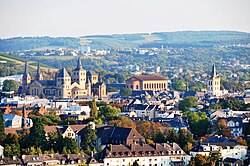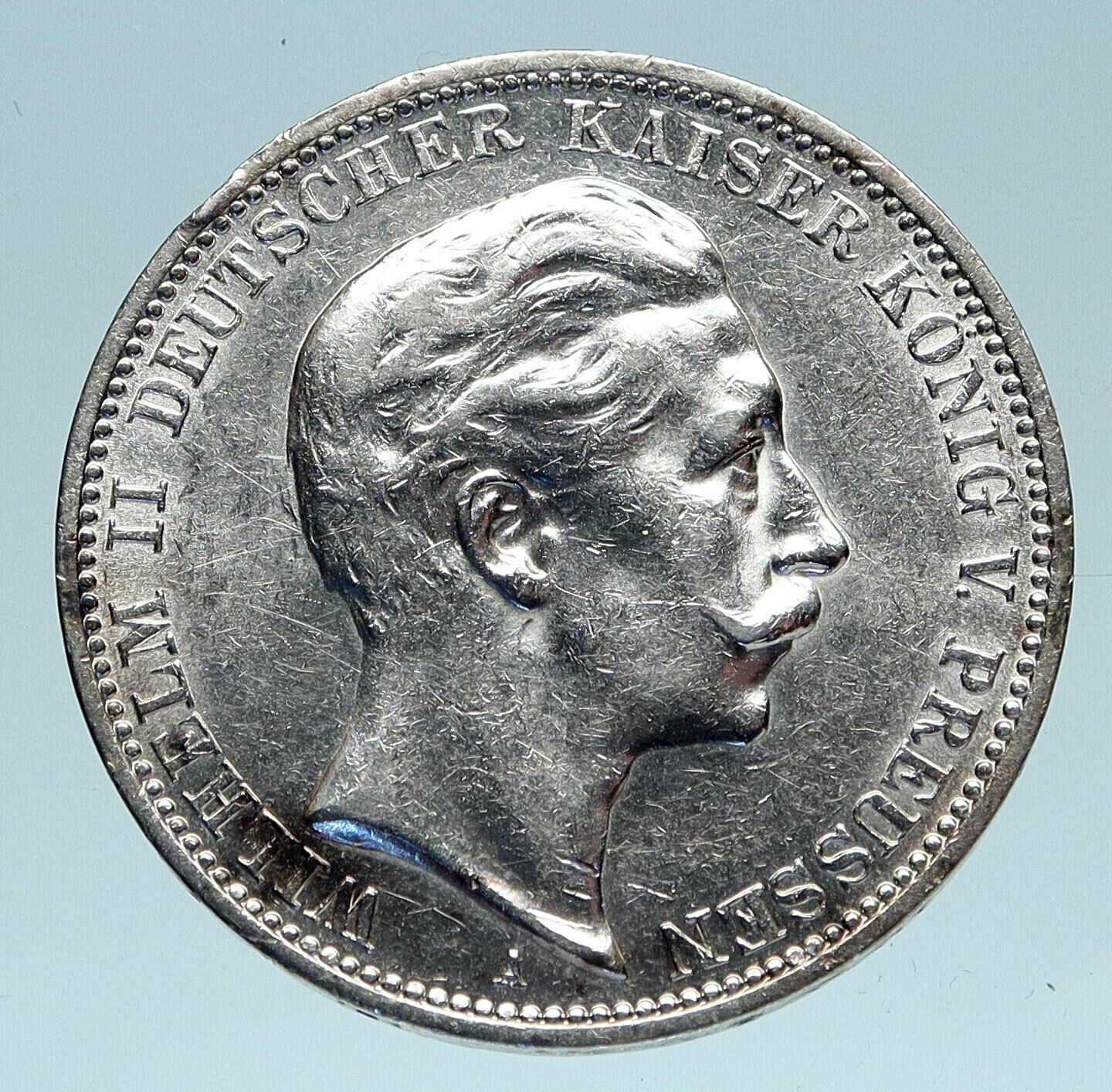|
Item: i107482
 
Authentic Coin of:
|
|
ARCHBISHOPRIC of TRIER, Germany
Johan Hugo von Orsbeck – Archbishop: (1675-1711)
1708 Silver 3 Petermenger 22mm (1.69 grams)
Reference: KM# 191 (1705-1709)
1705 CHVR TR LANDMVNTZ, Shield of arms topped by elector’s cap divides date.
G III G PETERMENGER, Bust of St. Peter with key and book in clouds, value below in inner circle.
You are bidding on the exact item pictured, provided with a Certificate of Authenticity and Lifetime Guarantee of Authenticity.
|
|

| Johann Hugo von Orsbeck (1634–1711) was the Archbishop-Elector of Trier from 1675 to 1711.
|
| Johann Hugo von Orsbeck was born in Weilerswist on January 30, 1634, the son of Wilhelm von Orsbeck, Herr von Vernich († 1648) and of Katharina von der Leyen († 1673). His mother was the sister of Karl Kaspar von der Leyen-Hohengeroldseck, Archbishop of Trier, and of Damian Hartard von der Leyen-Hohengeroldseck, Archbishop of Mainz. Johann Hugo von Orsbeck and his brother Damian Emmerich von Orsbeck (1632-1682) studied at Cologne, beginning in 1642, and then in 1648, was sent to the Jesuit school in Mainz. Johann Hugo von Orsbeck received the tonsure in 1650. In 1652, the brothers were sent to the Collegium Germanicum in Rome.
|
| Johann Hugo von Orsbeck finished his theological studies in 1655 and embarked on a two-month trip to Italy. In the meantime he was taken into the cathedral chapter of the Cathedral of Trier (1651) and Speyer Cathedral (1653). He spent 1655-57 studying at the University of Paris and at Pont-à-Mousson. He received the minor orders in 1658 and became a canon of the Cathedral of Trier and Speyer Cathedral. He was elected dean of Speyer Cathedral in 1660.
|
| On January 7, 1672, the cathedral chapter of the Cathedral of Trier elected Johann Hugo von Orsbeck coadjutor Archbishop of Trier (alongside his uncle Karl Kaspar von der Leyen-Hohengeroldseck). This appointment was confirmed by Pope Clement X on December 12, 1672, and he was appointed Titular Archbishop of Larissa. He was ordained as a priest on March 24, 1674. The cathedral chapter of Speyer Cathedral elected Orsbeck Bishop of Speyer on July 16, 1675. He succeeded his uncle as Archbishop of Trier upon the death of his uncle on June 1, 1676. He was formally installed as Archbishop on July 23, 1676. Pope Innocent XI confirmed his appointment as Bishop of Speyer on May 10, 1677. Johann Heinrich von Anethan, Auxiliary Bishop of Cologne, consecrated Orsbeck as a bishop on November 7, 1677.
|
| During the War of the Reunions, the Archbishopric of Trier was occupied by troops of the Kingdom of France in June and July 1684. The French again invaded the archbishopric and the Bishopric of Speyer with the outbreak of the Nine Years’ War in 1688. During the course of this occupation, the towns of Cochem, Mayen, and Wittlich were burned.
|
| On January 24, 1690, Orsbeck participated in the imperial election that elected the future Joseph I, Holy Roman Emperor as King of the Romans.
|
| Soon after the outbreak of the War of the Spanish Succession, Orsbeck on May 8, 1702 entered into a defensive alliance with the Kingdom of England and the Dutch Republic against the Kingdom of France. In October 1702, French troops under Camille d’Hostun, duc de Tallard occupied the Archbishopric of Trier, staying there until after the English victory at the Battle of Blenheim (August 13, 1704) and leaving in October 1704.
|
| On September 24, 1710, Orsbeck oversaw the election of Charles Joseph of Lorraine as his coadjutor and chosen successor.
|
| Orsbeck died in Trier on January 6, 1711.
|
|
 Trier, formerly known in English as Treves (/trɛv/ TREV; French: Trèves Latin: Treverorum) and Triers (see also names in other languages), is a city on the banks of the Moselle in Germany. It lies in a valley between low vine-covered hills of red sandstone in the west of the state of Rhineland-Palatinate, near the border with Luxembourg and within the important Moselle wine region. Trier, formerly known in English as Treves (/trɛv/ TREV; French: Trèves Latin: Treverorum) and Triers (see also names in other languages), is a city on the banks of the Moselle in Germany. It lies in a valley between low vine-covered hills of red sandstone in the west of the state of Rhineland-Palatinate, near the border with Luxembourg and within the important Moselle wine region.
Founded by the Celts in the late 4th century BC as Treuorum and conquered 300 years later by the Romans, who renamed it Augusta Treverorum (“The City of Augustus among the Treveri”), Trier is considered Germany’s oldest city. It is also the oldest seat of a bishop north of the Alps. In the Middle Ages, the archbishop-elector of Trier was an important prince of the Church who controlled land from the French border to the Rhine. The archbishop-elector of Trier also had great significance as one of the seven electors of the Holy Roman Empire.
With an approximate population of 105,000, Trier is the fourth-largest city in its state, after Mainz, Ludwigshafen, and Koblenz. The nearest major cities are Luxembourg (50 km or 31 mi to the southwest), Saarbrücken (80 kilometres or 50 miles southeast), and Koblenz (100 km or 62 mi northeast).
The University of Trier, the administration of the Trier-Saarburg district and the seat of the ADD (Aufsichts- und Dienstleistungsdirektion), which until 1999 was the borough authority of Trier, and the Academy of European Law (ERA) are all based in Trier. It is one of the five “central places” of the state of Rhineland-Palatinate. Along with Luxembourg, Metz and Saarbrücken, fellow constituent members of the QuattroPole union of cities, it is central to the greater region encompassing Saar-Lor-Lux (Saarland, Lorraine and Luxembourg), Rhineland-Palatinate, and Wallonia.
|
|
|
  Germany, officially the Federal Republic of Germany is a federal parliamentary republic in western-central Europe. It includes 16 constituent states and covers an area of 357,021 square kilometres (137,847 sq mi) with a largely temperate seasonal climate. Its capital and largest city is Berlin. With 81 million inhabitants, Germany is the most populous member state in the European Union. After the United States, it is the second most popular migration destination in the world. Germany, officially the Federal Republic of Germany is a federal parliamentary republic in western-central Europe. It includes 16 constituent states and covers an area of 357,021 square kilometres (137,847 sq mi) with a largely temperate seasonal climate. Its capital and largest city is Berlin. With 81 million inhabitants, Germany is the most populous member state in the European Union. After the United States, it is the second most popular migration destination in the world.
Various Germanic tribes have occupied northern Germany since classical antiquity. A region named Germania was documented before 100 CE. During the Migration Period the Germanic tribes expanded southward. Beginning in the 10th century, German territories formed a central part of the Holy Roman Empire. During the 16th century, northern German regions became the centre of the Protestant Reformation.
The rise of Pan-Germanism inside the German Confederation resulted in the unification of most of the German states in 1871 into the Prussian-dominated German Empire. After World War I and the German Revolution of 1918-1919, the Empire was replaced by the parliamentary Weimar Republic. The establishment of the Third Reich in 1933 led to World War II and the Holocaust. After 1945, Germany split into two states, East Germany and West Germany. In 1990, the country was reunified.
 In the 21st century, Germany is a great power and has the world’s fourth-largest economy by nominal GDP, as well as the fifth-largest by PPP. As a global leader in several industrial and technological sectors, it is both the world’s third-largest exporter and importer of goods. Germany is a developed country with a very high standard of living sustained by a skilled and productive society. It upholds a social security and universal health care system, environmental protection and a tuition free university education. In the 21st century, Germany is a great power and has the world’s fourth-largest economy by nominal GDP, as well as the fifth-largest by PPP. As a global leader in several industrial and technological sectors, it is both the world’s third-largest exporter and importer of goods. Germany is a developed country with a very high standard of living sustained by a skilled and productive society. It upholds a social security and universal health care system, environmental protection and a tuition free university education.
Germany was a founding member of the European Union in 1993. It is part of the Schengen Area, and became a co-founder of the Eurozone in 1999. Germany is a member of the United Nations, NATO, the G8, the G20, and the OECD. The national military expenditure is the 9th highest in the world. Known for its rich cultural history, Germany has been continuously the home of influential artists, philosophers, musicians, sportsmen, entrepreneurs, scientists and inventors.
|
|
|






 Trier, formerly known in English as Treves (/trɛv/ TREV; French: Trèves Latin: Treverorum) and Triers (see also names in other languages), is a city on the banks of the Moselle in Germany. It lies in a valley between low vine-covered hills of red sandstone in the west of the state of Rhineland-Palatinate, near the border with Luxembourg and within the important Moselle wine region.
Trier, formerly known in English as Treves (/trɛv/ TREV; French: Trèves Latin: Treverorum) and Triers (see also names in other languages), is a city on the banks of the Moselle in Germany. It lies in a valley between low vine-covered hills of red sandstone in the west of the state of Rhineland-Palatinate, near the border with Luxembourg and within the important Moselle wine region.

 Germany, officially the Federal Republic of Germany is a federal parliamentary republic in western-central Europe. It includes 16 constituent states and covers an area of 357,021 square kilometres (137,847 sq mi) with a largely temperate seasonal climate. Its capital and largest city is Berlin. With 81 million inhabitants, Germany is the most populous member state in the European Union. After the United States, it is the second most popular migration destination in the world.
Germany, officially the Federal Republic of Germany is a federal parliamentary republic in western-central Europe. It includes 16 constituent states and covers an area of 357,021 square kilometres (137,847 sq mi) with a largely temperate seasonal climate. Its capital and largest city is Berlin. With 81 million inhabitants, Germany is the most populous member state in the European Union. After the United States, it is the second most popular migration destination in the world. In the 21st century, Germany is a great power and has the world’s fourth-largest economy by nominal GDP, as well as the fifth-largest by PPP. As a global leader in several industrial and technological sectors, it is both the world’s third-largest exporter and importer of goods. Germany is a developed country with a very high standard of living sustained by a skilled and productive society. It upholds a social security and universal health care system, environmental protection and a tuition free university education.
In the 21st century, Germany is a great power and has the world’s fourth-largest economy by nominal GDP, as well as the fifth-largest by PPP. As a global leader in several industrial and technological sectors, it is both the world’s third-largest exporter and importer of goods. Germany is a developed country with a very high standard of living sustained by a skilled and productive society. It upholds a social security and universal health care system, environmental protection and a tuition free university education.




